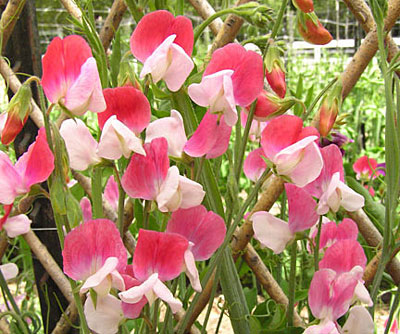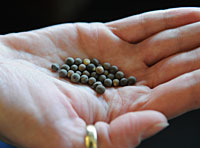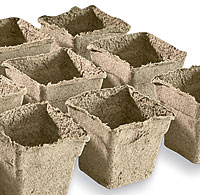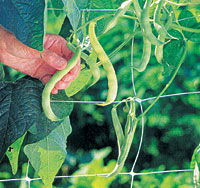






When I started working at Gardener's Supply in the 1990s, my Vermont backyard was pretty green—with grass. Today, there's just a tiny bit of the original lawn left. Most of the available space has given way to trees, shrubs, perennials, annuals and stonework. Watch a slideshow of my garden in Burlington, VT.
In addition to my work at Gardener's Supply, I work in the gardening division at Church Hill Landscapes. In that role, I maintain dozens of gardens and learn a lot in the process. I believe that all gardening is good gardening.

Sweet peas are easy to grow. The most important thing: get them in the ground early to take advantage of cool spring weather. All varieties, such as this Painted Lady from Renee’s Garden Seeds, make excellent cut flowers.

Sweet pea seeds are about 1/8″, so they're especially easy to plant. A good project for kids.

Start sweet peas in Cowpots. The biodegradable pots can be put right into the ground, reducing transplant stress.

Shown here with pole beans, Nearly Invisible Netting can be used to convert any vertical space into a suitable trellis.
IF you want to grow flowers from seed, start with sweet peas. The large seeds are easy to manage and most varieties germinate readily. Plus, the resulting blooms are gorgeous and sweetly scented.
Sweet peas come in a huge array of colors and patterns. Most will grow to 5 or 6 feet, but there are shorter varieties "bush type" that are well-suited to containers. To extend the blooming season, choose a few different types. Read the seed packets to find varieties that bloom early (“short-day”) and late (“long day”). Although most sweet peas are annuals, you can also get perennial sweet peas (Lathyrus latifolia).
Sweet peas (Lathyrus odoratus) thrive in cool temperatures, so it's important to get them blooming early, before summer heat knocks them out. You can plant them outdoors as soon as the soil can be worked in spring. Chances are it will still be quite cold, but the seeds will be fine. Gardeners in the south can start sweet peas in late fall for bloom in late winter or early spring. Check with your cooperative extension for best practice in your area.
To ensure the longest-possible season of bloom, start your peas indoors. Timing is based on the last frost date in your area. Once you have that date, back it up four to six weeks. That's when you plant. For instance, if your last frost date is May 15, you should plant in early to mid-April. Don't know the last frost date in your area? Check with your cooperative extension, or a good gardener in the neighborhood.
Whether you're planting indoors or out, it's a good idea to break or soften the hard seed coat before planting. You can do this by soaking the seeds overnight in water or nicking the brown coating with a nail clippers or a piece of sandpaper.
If you start your seeds indoors, use biodegradable pots, such as Cowpots, homemade Paper Pots or peat pots. The seedlings resent root disturbance, so it's best to have a pot that can go in the ground right along with your transplants.
Plant the vines about 6″ apart in a sunny location, ideally with protection from intense, afternoon sun. Unless you've selected a bush-type, your peas will need strings or a trellis of some kind. Peas use tendrils to climb. They can grasp anything that's a quarter-inch or less. Anything bigger won't work. The best support is string, twine, or netting with a grid that’s at least 2″ x 2″ . Netting with smaller openings — ½″ or 1″ — will not work well. Trellis netting, such as Nearly Invisible Netting or Biodegradable Netting, is ideal.
Mulch the soil surface to help keep the roots cool. Water if rainfall is insufficient and fertilize every 15 days or so with liquid fertilizer.
To keep your vine productive, cut flowers frequently and remove the faded blossoms. Once summer heat arrives, your vine might turn brown and die, which is normal. At that point, you can pull it out and replant with something else. Some varieties tolerate heat better than others, such as Starry Night and Cupani's Original, so check your seed packets.
How To Grow Flowering Dogwood Trees From Seed
How to Plant Sweet Potatoes from Slips to Grow Sweet Potatoes that Last
How to Grow Flowering Dogwood Trees from Seed
How to Grow Peony Poppies From Seed Outdoors
How to Grow Flowering Dogwood Trees from Seed
Do Spider Plants Have Seeds: How To Grow A Spider Plant From Seed
Copyright © www.100flowers.win Botanic Garden All Rights Reserved